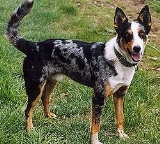
Koolie
Encyclopedia
The Koolie or Coolie, also known as the Australian Koolie or the German Koolie is an Australia
n dog
breed
. Specifically, it is a herding dog
, a subcategory of a working dog
. Koolies have existed in Australia since the early 19th century, established through old photos owned by elder Koolie breeders and personal records such as diaries.
The Koolie Club of Australia defines the breed based on its ability to work rather than on its conformation
. However, most Koolie breeders refer to the Koolie as a breed rather than as a type, and assert that it "breeds true", with various types or strains within the breed.
Many countries will gather their working dog
s under the same category like Germany with their herding dog
breeds all classed as Altdeutsche Hütehunde (heading dogs). New Zealand not only classify their breeds this way, but they also grade them by their working traits. Koolies in New Zealand are registered as a "heading dog": A dog which has a natural instinct to cast out (i.e., circle widely), round sheep and bring them back to their owner. The Koolie is known as a silent working dog. They are used for “heading” sheep and also for quiet careful work at close quarters at lambing time or for “shedding” (cutting out) sheep. It is only through the registrar of the Australian Koolie Club that these bloodlines remain an integral part of the breed and are active contributors to the Koolie gene pool. New Zealand Koolie breeders are working towards having the Koolie recognised under their own breed name as they have been in Australia.
 The Koolie is as diverse as the country it originates from, Australia
The Koolie is as diverse as the country it originates from, Australia
. In the north of Queensland and New South Wales they are tall, medium boned and agile, bred for mustering Simmental Cattle
and Brahma over many miles.
In The Hunter Valley region and Snowy Mountains of New South Wales, they're thicker set and shorter to flush low lying cattle from the dense bush and gullies.
In Victoria, one finds the smallest variety of the Koolie.
Koolies are bred to meet the needs of the stockman, grazier and farmer, all agile, all with the same ability to adapt to any situation, all with a strong willingness drive.
The Koolie vary from 40 to 60 cm (15.7 to 23.6 ) in size and are a contrast of coat, colour and body type, although they are merle
d coat pattern.
The solid red or black Koolie are often mistaken for Kelpies, and some bi coloured Koolie have been taken for Border Collies by the general public, rarely if ever by breeders.
As all of these breeds share Collie ancestry, they resemble each other.
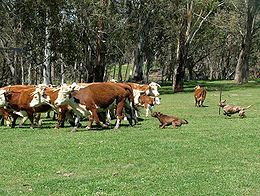 The Koolie coat ranges from short/smooth (like that of the original blue merle Collies from Scotland) short (like a working Kelpie
The Koolie coat ranges from short/smooth (like that of the original blue merle Collies from Scotland) short (like a working Kelpie
) medium and not common long (like the show Border Collie
). Koolies are typically slightly longer than tall. The majority of owners prefer the short/smooth coats as they do not pick up grass seed, bur and are very easy to maintain, with the occasional swim to keep the coat glossy and free of parasites.
Black Koolies will commonly have a black nose with black eyes, or tones of black including blue.
Red or chocolate Koolies will commonly have a red or chocolate nose with brown eyes, or tones of brown, including yellow, and there can be combinations of both black or brown with the added blue eye.
The temperament found in a Koolie is a culmination of these much sought after abilities. The optimal worker possesses a combination of working skills and bonding temperament.
There are times when an uninitiated dog owner or a new enthusiast mistakes the Koolie as a shy, reserved or even a timid animal. The Koolie's temperament needs to be understood in proper context when one seeks an optimal match of skills and demeanour. Koolies are intelligent animals, and the most experienced handlers know well that they need guidance in training. A steady and supportive approach will be productive, proving the Koolie's adaptability in diverse situations when given time.
Owners will be rewarded through the Koolie's diligence in varied roles such as in work situations, sporting activities, loyal service or the time honoured role of companionship. Known to be patient, temperate, dedicated, with a strong sense of willingness and devotion; the Koolie is not naturally aggressive but can demonstrate dominance. They show an untiring enthusiasm for work and an admirable hardiness when the job or circumstance requires.
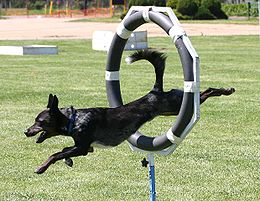 The median longevity of Koolies is about 18 years, which is a typical lifespan for this breed.
The median longevity of Koolies is about 18 years, which is a typical lifespan for this breed.
Koolies have a diverse gene pool and so do not suffer from the many genetic problems found in recognised breeds, but the merle for which the Koolie is most recognised by can and does produce white blind and or deaf pups.
It is highly recommended that when considering breeding, that matings of merle to solid are the safest option.
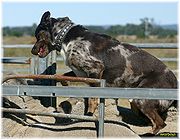 Koolies are much sought-after in rural Australia, and interest is now being shown in America, Canada, Germany, Finland, New Zealand and Tasmania. According to
Koolies are much sought-after in rural Australia, and interest is now being shown in America, Canada, Germany, Finland, New Zealand and Tasmania. According to
Geoff Broughton, past president of the Koolie Club of Australia for 7 years, the Koolie will head (move to the front or head of the stock to push them back towards you), heel or drive, (push the stock from behind), cast (move out and around the stock), block (hold the stock or block them from in front, in three sheep trials this action is called the pick up) and back (literally jump onto the backs of their charges to herd them if necessary). Koolies have a reputation for being upright workers with a good eye, who can easily shift their focus from holding the group to casting around a flock or gathering breakaways. They are not known for having "sticky eyes" (focusing on the sheep in front only). Unlike other working breeds, which are noted for their crouched form or style and preference for either yard or field work, Koolies are at ease working in closed surroundings such as yards or trucks and being out in paddocks and droving. As well as working anything from duck
s to bull
s, like all dogs of their kind they will herd family members and children in the absence of other charges.
Herding instincts and trainability can be measured at noncompetitive herding tests. Koolies exhibiting basic herding instincts can be trained to compete in stock dog trials.
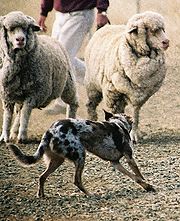 The Koolie’s ancestors were the German Tiger (imported into South Australia in the 19th century) a German working breed which are part of the German Alpine Header Breeds, the smooth coated blue merle Collie (imported from Europe also in the 19th century) and the Black and Tan Collie from the Highlands of Scotland, these were the same type imported by Thomas Hall for the creation of his Heelers. The Koolie is believed to be descended from the same Collie
The Koolie’s ancestors were the German Tiger (imported into South Australia in the 19th century) a German working breed which are part of the German Alpine Header Breeds, the smooth coated blue merle Collie (imported from Europe also in the 19th century) and the Black and Tan Collie from the Highlands of Scotland, these were the same type imported by Thomas Hall for the creation of his Heelers. The Koolie is believed to be descended from the same Collie
types that were brought to Australia for the kennels of Thomas S. Hall (an originator of the Australian Cattle Dog breed); some believe that they could be direct descendants of Hall's dogs. This, if true, would make the Koolie one of the oldest of Australia's breeds. Capt.v.Stephanitz, German Author of the book "The German Shepherd Dog" (8th revision and enlarged edition) wrote of German Tigers on page 167, describing them clearly as dogs with large dark brown to black spots or splashes or largish splashes on a lighter background found mostly in the South especially in the Brenztal, on page 252 he wrote of the importations into Australia by Graziers of German "Shepherd" Dogs (not to be confused with the current recognised form of German Shepherd), these were German working breeds used by Shepherds in Germany to influence the bloodlines of our own working breeds.
According to older Koolie breeders personal records, from diaries and photo albums the Koolie has been around for over 160 years. During the industrial era some bloodlines were influenced by Kelpie and Border Collie, as explained by one grazier in Western Australia, "You bred from the good workers which were around and Koolies were not always to be found, so you bred to the next best worker that was and this was either the Kelpie or Border depending on the region you lived and the stock you worked".
In 2000, the Koolie Club of Australia was formed to preserve, protect and ethically promote the Koolie breed. The Koolie Club does not actively work towards bench standard recognition, feeling this would only be detrimental to the breeds working future. As of (2008), no bench standard
exists.
In 2004, The Koolie breed was recognized by the Australian Sporting Registrar, judges from the Australian National Kennel Council
(ANKC) may judge Koolies in all ANKC sanctioned sporting trials. In the states of Victoria
, New South Wales
, and Queensland
, registered Koolies may compete in, herding, obedience, tracking, jumping, gambles and dog agility
events through registration on their State's Sporting Register as members of the Koolie Club of Australia.
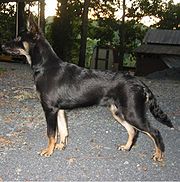 In May 2006, the Stockdog Committee of the voted to accept the "Koolie/German Coolie" into their list of recognised and accepted herding breeds, admission was granted June 2006.
In May 2006, the Stockdog Committee of the voted to accept the "Koolie/German Coolie" into their list of recognised and accepted herding breeds, admission was granted June 2006.
In 2006, The American Herding Breed Association accepted the Australian Koolie onto their list of recognised and accepted breeds.
In 2003, at the Koolie Club of Australia's Annual General meeting a unanimous vote was returned to appoint Ms Revels the clubs official representative in America, Ms Revels was instrumental in gaining acceptance of the Australian Koolie to the recognised breeds lists of the American Herding Breed Association.
In 2008, The first Exportation to New Zealand of a registered DNA tested Koolie was orchestrated by the Koolie Club of Australia, for Ms Penny Nalders of Wellington, NewZealand.
In 2008, The first Exportations to Finland of registered DNA tested Koolies was orchestrated by the Koolie Club of Australia, for Ms Sinikka Kumpusalmi of Vehmersalmi, and Mrs Satu Tasanen of Honkilahti, Finland.
Australia
Australia , officially the Commonwealth of Australia, is a country in the Southern Hemisphere comprising the mainland of the Australian continent, the island of Tasmania, and numerous smaller islands in the Indian and Pacific Oceans. It is the world's sixth-largest country by total area...
n dog
Dog
The domestic dog is a domesticated form of the gray wolf, a member of the Canidae family of the order Carnivora. The term is used for both feral and pet varieties. The dog may have been the first animal to be domesticated, and has been the most widely kept working, hunting, and companion animal in...
breed
Breed
A breed is a group of domestic animals or plants with a homogeneous appearance, behavior, and other characteristics that distinguish it from other animals or plants of the same species. Despite the centrality of the idea of "breeds" to animal husbandry, there is no scientifically accepted...
. Specifically, it is a herding dog
Herding dog
A herding dog, also known as a stock dog or working dog, is a type of pastoral dog that either has been trained in herding or belongs to breeds developed for herding...
, a subcategory of a working dog
Working dog
A working dog refers to a canine working animal, i.e., a type of dog that is not merely a pet but learns and performs tasks to assist and/or entertain its human companions, or a breed of such origin...
. Koolies have existed in Australia since the early 19th century, established through old photos owned by elder Koolie breeders and personal records such as diaries.
The Koolie Club of Australia defines the breed based on its ability to work rather than on its conformation
Conformation show
Conformation shows, also referred to as breed shows, are a kind of dog show in which a judge familiar with a specific dog breed evaluates individual purebred dogs for how well the dogs conform to the established breed type for their breed, as described in a breed's individual breed standard.A...
. However, most Koolie breeders refer to the Koolie as a breed rather than as a type, and assert that it "breeds true", with various types or strains within the breed.
Many countries will gather their working dog
Working dog
A working dog refers to a canine working animal, i.e., a type of dog that is not merely a pet but learns and performs tasks to assist and/or entertain its human companions, or a breed of such origin...
s under the same category like Germany with their herding dog
Herding dog
A herding dog, also known as a stock dog or working dog, is a type of pastoral dog that either has been trained in herding or belongs to breeds developed for herding...
breeds all classed as Altdeutsche Hütehunde (heading dogs). New Zealand not only classify their breeds this way, but they also grade them by their working traits. Koolies in New Zealand are registered as a "heading dog": A dog which has a natural instinct to cast out (i.e., circle widely), round sheep and bring them back to their owner. The Koolie is known as a silent working dog. They are used for “heading” sheep and also for quiet careful work at close quarters at lambing time or for “shedding” (cutting out) sheep. It is only through the registrar of the Australian Koolie Club that these bloodlines remain an integral part of the breed and are active contributors to the Koolie gene pool. New Zealand Koolie breeders are working towards having the Koolie recognised under their own breed name as they have been in Australia.
Appearance

Australia
Australia , officially the Commonwealth of Australia, is a country in the Southern Hemisphere comprising the mainland of the Australian continent, the island of Tasmania, and numerous smaller islands in the Indian and Pacific Oceans. It is the world's sixth-largest country by total area...
. In the north of Queensland and New South Wales they are tall, medium boned and agile, bred for mustering Simmental Cattle
Simmental Cattle
Simmental cattle are a versatile breed of cattle originating in the valley of the Simme river, in the Bernese Oberland of western Switzerland.-European origin:...
and Brahma over many miles.
In The Hunter Valley region and Snowy Mountains of New South Wales, they're thicker set and shorter to flush low lying cattle from the dense bush and gullies.
In Victoria, one finds the smallest variety of the Koolie.
Koolies are bred to meet the needs of the stockman, grazier and farmer, all agile, all with the same ability to adapt to any situation, all with a strong willingness drive.
The Koolie vary from 40 to 60 cm (15.7 to 23.6 ) in size and are a contrast of coat, colour and body type, although they are merle
Merle
Merle may refer to:*A name for the Common Blackbird, or any of the varieties of Icterids of which the male is predominantly black*Merle , a pattern in dogs’ coats*MS Merle, a ferry formerly operated by Belfast Freight Ferries...
d coat pattern.
The solid red or black Koolie are often mistaken for Kelpies, and some bi coloured Koolie have been taken for Border Collies by the general public, rarely if ever by breeders.
As all of these breeds share Collie ancestry, they resemble each other.
Coat

Australian Kelpie
The Kelpie is an Australian sheep dog successful at mustering and droving with little or no command guidance. They are medium-sized dogs and come in a variety of colours...
) medium and not common long (like the show Border Collie
Border Collie
The Border Collie is a herding dog breed developed in the Anglo-Scottish border region for herding livestock, especially sheep. It is the most widespread of the collie breeds....
). Koolies are typically slightly longer than tall. The majority of owners prefer the short/smooth coats as they do not pick up grass seed, bur and are very easy to maintain, with the occasional swim to keep the coat glossy and free of parasites.
Colouring
Koolie colours can be solid (all one colour black or red/chocolate this includes Koolie who are cryptic merle: carry the merle gene but do not display it obviously) "bi" (black & white or red & white) "tri" (solid red or black, with white markings, normally with brown points), or "tri merle" (same description but merle) "merle" (grey, black,red/chocolate or white undercoat with large splashes of darker colourings of red/chocolate for red merles or black, grey for blue merles).Black Koolies will commonly have a black nose with black eyes, or tones of black including blue.
Red or chocolate Koolies will commonly have a red or chocolate nose with brown eyes, or tones of brown, including yellow, and there can be combinations of both black or brown with the added blue eye.
Temperament
Graziers, stockmen and dairy farmers across Australia since days long past have typically selected breeds which display the abilities required to meet their working needs.The temperament found in a Koolie is a culmination of these much sought after abilities. The optimal worker possesses a combination of working skills and bonding temperament.
There are times when an uninitiated dog owner or a new enthusiast mistakes the Koolie as a shy, reserved or even a timid animal. The Koolie's temperament needs to be understood in proper context when one seeks an optimal match of skills and demeanour. Koolies are intelligent animals, and the most experienced handlers know well that they need guidance in training. A steady and supportive approach will be productive, proving the Koolie's adaptability in diverse situations when given time.
Owners will be rewarded through the Koolie's diligence in varied roles such as in work situations, sporting activities, loyal service or the time honoured role of companionship. Known to be patient, temperate, dedicated, with a strong sense of willingness and devotion; the Koolie is not naturally aggressive but can demonstrate dominance. They show an untiring enthusiasm for work and an admirable hardiness when the job or circumstance requires.
Health

Koolies have a diverse gene pool and so do not suffer from the many genetic problems found in recognised breeds, but the merle for which the Koolie is most recognised by can and does produce white blind and or deaf pups.
It is highly recommended that when considering breeding, that matings of merle to solid are the safest option.
Medical research
- In 2003 DNA testing carried out on 56 individual Koolie bloodlines from Australia by Dr. Mark Neff of the University of California at Davis in the USA cleared those bloodlines tested for the presence of the mutant gene mdr1-1, which causes malfunction in the canine multidrug resistance gene; CollieCollieThe collie is a distinctive type of herding dog, including many related landraces and formal breeds. It originates in Scotland and Northern England. It is a medium-sized, fairly lightly built dog with a pointed snout, and many types have a distinctive white pattern over the shoulders. Collies...
bloodlines were chosen to be tested because they showed a reaction, even death, to chemicals, such as Ivermectin, used in the treatment of intestinal parasites.
- In 2004, the Koolie club of Australia in conjunction with Genetic Science Service of Australia launched the collection and processing of Koolie DNA, which continues to test for all current CollieCollieThe collie is a distinctive type of herding dog, including many related landraces and formal breeds. It originates in Scotland and Northern England. It is a medium-sized, fairly lightly built dog with a pointed snout, and many types have a distinctive white pattern over the shoulders. Collies...
diseases and family relationships. To date, the Koolie Club of Australia’s database records show that their registered Koolie breed is relatively free of common genetic disorders that are found in recognised pure breeds, thanks to DNA testing. It is generally accepted that this is due to the natural breeding selection, which has continued unhindered for over 160 years.
- In 2007, the Koolie Club of Australia through Genetic Science Service of Australia gained access to the Merle test, discovered in 2006 by Dr. Keith Murphy’s laboratory of the Department of Pathobiology at the College of Veterinary Medicine and Biomedical Sciences of Texas A&M University more info
- In 2008, Koolies registered with the Koolie Club of Australia have undertaken a breed Specifity test to identify the Koolie genetically, the results will help discover and create stronger bloodlines.
Herding technique

Geoff Broughton, past president of the Koolie Club of Australia for 7 years, the Koolie will head (move to the front or head of the stock to push them back towards you), heel or drive, (push the stock from behind), cast (move out and around the stock), block (hold the stock or block them from in front, in three sheep trials this action is called the pick up) and back (literally jump onto the backs of their charges to herd them if necessary). Koolies have a reputation for being upright workers with a good eye, who can easily shift their focus from holding the group to casting around a flock or gathering breakaways. They are not known for having "sticky eyes" (focusing on the sheep in front only). Unlike other working breeds, which are noted for their crouched form or style and preference for either yard or field work, Koolies are at ease working in closed surroundings such as yards or trucks and being out in paddocks and droving. As well as working anything from duck
Duck
Duck is the common name for a large number of species in the Anatidae family of birds, which also includes swans and geese. The ducks are divided among several subfamilies in the Anatidae family; they do not represent a monophyletic group but a form taxon, since swans and geese are not considered...
s to bull
Bull
Bull usually refers to an uncastrated adult male bovine.Bull may also refer to:-Entertainment:* Bull , an original show on the TNT Network* "Bull" , an episode of television series CSI: Crime Scene Investigation...
s, like all dogs of their kind they will herd family members and children in the absence of other charges.
Herding instincts and trainability can be measured at noncompetitive herding tests. Koolies exhibiting basic herding instincts can be trained to compete in stock dog trials.
History

Collie
The collie is a distinctive type of herding dog, including many related landraces and formal breeds. It originates in Scotland and Northern England. It is a medium-sized, fairly lightly built dog with a pointed snout, and many types have a distinctive white pattern over the shoulders. Collies...
types that were brought to Australia for the kennels of Thomas S. Hall (an originator of the Australian Cattle Dog breed); some believe that they could be direct descendants of Hall's dogs. This, if true, would make the Koolie one of the oldest of Australia's breeds. Capt.v.Stephanitz, German Author of the book "The German Shepherd Dog" (8th revision and enlarged edition) wrote of German Tigers on page 167, describing them clearly as dogs with large dark brown to black spots or splashes or largish splashes on a lighter background found mostly in the South especially in the Brenztal, on page 252 he wrote of the importations into Australia by Graziers of German "Shepherd" Dogs (not to be confused with the current recognised form of German Shepherd), these were German working breeds used by Shepherds in Germany to influence the bloodlines of our own working breeds.
According to older Koolie breeders personal records, from diaries and photo albums the Koolie has been around for over 160 years. During the industrial era some bloodlines were influenced by Kelpie and Border Collie, as explained by one grazier in Western Australia, "You bred from the good workers which were around and Koolies were not always to be found, so you bred to the next best worker that was and this was either the Kelpie or Border depending on the region you lived and the stock you worked".
In 2000, the Koolie Club of Australia was formed to preserve, protect and ethically promote the Koolie breed. The Koolie Club does not actively work towards bench standard recognition, feeling this would only be detrimental to the breeds working future. As of (2008), no bench standard
Breed standard
A breed standard in animal fancy and animal husbandry is a set of guidelines which is used to ensure that the animals produced by a breeder or breeding facility conform to the specifics of the breed....
exists.
In 2004, The Koolie breed was recognized by the Australian Sporting Registrar, judges from the Australian National Kennel Council
Australian National Kennel Council
The Australian National Kennel Council is the peak body in Australia responsible for promoting breeding, showing, trialling, obedience, and other canine-related activities and the ownership of temperamentally and physically sound purebred dogs by individuals across Australia. It was formed in...
(ANKC) may judge Koolies in all ANKC sanctioned sporting trials. In the states of Victoria
Victoria (Australia)
Victoria is the second most populous state in Australia. Geographically the smallest mainland state, Victoria is bordered by New South Wales, South Australia, and Tasmania on Boundary Islet to the north, west and south respectively....
, New South Wales
New South Wales
New South Wales is a state of :Australia, located in the east of the country. It is bordered by Queensland, Victoria and South Australia to the north, south and west respectively. To the east, the state is bordered by the Tasman Sea, which forms part of the Pacific Ocean. New South Wales...
, and Queensland
Queensland
Queensland is a state of Australia, occupying the north-eastern section of the mainland continent. It is bordered by the Northern Territory, South Australia and New South Wales to the west, south-west and south respectively. To the east, Queensland is bordered by the Coral Sea and Pacific Ocean...
, registered Koolies may compete in, herding, obedience, tracking, jumping, gambles and dog agility
Dog agility
Dog agility is a dog sport in which a handler directs a dog through an obstacle course in a race for both time and accuracy. Dogs run off-leash with no food or toys as incentives, and the handler can touch neither dog nor obstacles...
events through registration on their State's Sporting Register as members of the Koolie Club of Australia.

In 2006, The American Herding Breed Association accepted the Australian Koolie onto their list of recognised and accepted breeds.
Exports
In 2002, The first Exportation to America of a registered DNA tested Koolie was orchestrated by the Koolie Club of Australia, for Ms Torry Lynn Revels of North Carolina, USA.In 2003, at the Koolie Club of Australia's Annual General meeting a unanimous vote was returned to appoint Ms Revels the clubs official representative in America, Ms Revels was instrumental in gaining acceptance of the Australian Koolie to the recognised breeds lists of the American Herding Breed Association.
In 2008, The first Exportation to New Zealand of a registered DNA tested Koolie was orchestrated by the Koolie Club of Australia, for Ms Penny Nalders of Wellington, NewZealand.
In 2008, The first Exportations to Finland of registered DNA tested Koolies was orchestrated by the Koolie Club of Australia, for Ms Sinikka Kumpusalmi of Vehmersalmi, and Mrs Satu Tasanen of Honkilahti, Finland.
External links
- The Koolie Club of Australia
- The Koolie Forum
- Wikifido-Koolie
- Koolie Rescue
- Genetic Technologies
- Author Jeanne Joy Hartnagle - Australian Shepherd, Origin & History
- New Zealand Working Breeds

